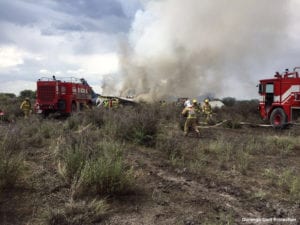6 rules to survive an emergency landing

Photos of the crash show the plane was mostly intact after impact, but the subsequent fire severely damaged it. In an ABC News report, Juan Rivera, a passenger on the flight said,
“I just seen a bunch of smoke, opened the door. I got out and started pulling people out. I looked at the side and there was a guy with two kids. That’s when I started getting the kids.”
Despite the fire and smoke, passengers did survive an emergency landing, though two were critically injured. Passengers suffered a variety of injuries and burns. Many survivors were well enough to be discharged from the hospital the day after the crash.
Those who have been in a crash or emergency landing know that an evacuation can be chaotic and frightening even without fire and cabin damage. I survived an aborted takeoff years ago. The plane came to a halt past the runway, then we evacuated via emergency chutes. Even with the plane still standing with no fire, many panicked.
In an emergency landing, most passengers survive an emergency landing. While the flight crew may be silent due to injury, or shouting directions when the plane comes to a halt, travelers that use common sense can survive an emergency landing. There may be smoke and fire outside or even in the cabin. Visibility may be obscured. The cabin may have broken glass and other wreckage strewn about.
While most air travelers know that commercial airplane crashes are rare, many under estimate the passenger survival rate. According to National Transportation Safety Board (NTSB) statistics, between 1983 and 2017, 56,695 passengers and crew flew on planes which had accidents, and 53,730 survived. That’s a 94.8 percent survival rate.
Even when looking solely at the 50 most serious accidents during those years, we find that 68 percent of passengers and crew survived. That survival rate includes the Pan Am Lockerbie bombing and the aircraft hijacked on 9/11, all of which had no survivors.
Regardless of cabin class and seat, passengers can substantially improve their survivability in the event of an aircraft emergency with a little planning and common sense.
Here are my top 6 rules for how to survive an emergency landing.
Clothing:
Save your sandals and flip-flops for the beach. Pack your high heels for the big gala or meeting in your bag. Wear sensible everyday or athletic shoes to protect yourself from the broken glass and other debris that can litter a cabin after a crash. Wear clothing made primarily from natural fibers. Synthetic fibers can melt on your skin in a fire, causing severe burns. Don’t wear loose clothing that can snag on wreckage.
Pants are preferred to dresses, skirts and shorts, if for no other reason than to protect you from friction burns when going down an evacuation slide. After an emergency evacuation, it could be quite a while before rescuers reach you, so, during takeoff or landing, when mishaps can be severe, if it’s cold outside, keep a coat or jacket in your lap. It was winter and below freezing when I evacuated from my plane. It was more than a half hour before buses arrived to pick us up.
Personal Emergency Plan:
The moment you board your flight, devise an emergency escape plan. Count the rows from your seat to the two closest exits, fore and aft. That way, if smoke fills the plane obscuring your vision or fire blocks an exit, you’ll know where to escape. You can count rows by feel as you pass them.
Remain Calm:
If you’re in an emergency and alerted to prepare for a crash landing, stay calm and follow the flight crew’s instructions to the letter. The odds are with you.
When the Plane Stops:
When the plane makes an emergency landing and comes to a stop, get out as fast as possible. If you’re traveling with family, evacuate them with you. Never crawl on the floor to avoid smoke, as you could be trampled. Don’t wait to be told what to do by the flight crew. They might be dazed or incapacitated and can’t help or give directions. Take your shoes off and hold them when going down the chute to prevent getting caught and injuring yourself. A fast but careful evacuation of the plane increases survivability.
Leave Your Belongings:
Don’t take any bags or other belongings with you during an evacuation. You need to keep your hands free to maintain your balance while stepping over and around debris and passengers’ belongings, or if pushed by panicking passengers.
Once Out of the Plane:
After you’re out of the plane, get as far from it as you can. If it’s not on fire, don’t forget that the fuel left in the plane’s tanks could ignite and cause an explosion. If that happens, thousands of deadly fragments could fly in all directions, so shield yourself, if possible.
In the event of a crash or emergency landing, stay calm and alert. Follow flight crew instructions. Exit the plane quickly, then get away from it. Remember, most passengers walk away safely from crashes and other emergencies.
(Image courtesy of Durango Civil Protection)
After many years working in corporate America as a chemical engineer, executive and eventually CFO of a multinational manufacturer, Ned founded a tech consulting company and later restarted NSL Photography, his photography business. Before entering the corporate world, Ned worked as a Public Health Engineer for the Philadelphia Department of Public Health. As a well known corporate, travel and wildlife photographer, Ned travels the world writing about travel and photography, as well as running photography workshops, seminars and photowalks. Visit Ned’s Photography Blog and Galleries.



